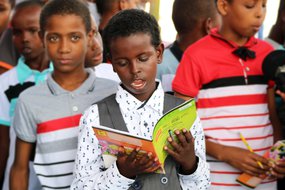
In 2022, more than half (55.7%) of children and young people aged 8 to 18 told us that they read non-fiction in their free time. For National Non-Fiction November, we looked at who was reading non-fiction and explored the differences between children and young people who did, and didn't, read non-fiction in relation to reading motivation and environmental engagement.
Key findings include:
- Non-fiction reading is popular regardless of gender and socio-economic background. A similar percentage of boys and girls (54.5% vs. 56.7%) and children who did and didn't receive free school meals (54.1% vs. 55.7%) said they read non-fiction in their free time.
- Comparing children who do and don't read non-fiction:
- Twice as many children and young people who read non-fiction said they read to learn more about the causes they care about (34.3% vs. 14.6%).
- In addition, twice as many non-fiction readers said they read to relax (62.0% vs. 33.4%), that reading makes them feel better (53.2% vs 26.0%) and that they read to feel connected to the world (28.3% vs 11.7%).
- While more than 1 in 4 (25.6%) children and young people say they read to learn more about the issues and causes they care about, this rises to more than 1 in 3 (34.3%) of those who read non-fiction.
- More non-fiction readers said that taking care of the environment was important to them (68.7% vs 48.6% of those who didn’t read non-fiction), felt they knew what to do to help look after the environment (69.2% vs 55.7%), and spoke to friends or family about the environment (56.5% vs 39.3%).
- More non-fiction readers also said that they had read (43.4% vs 18.7%) or written (18.4% vs 7.7%) about the environment in their spare time.
Overall, this report found that more children and young people who read non-fiction were motivated to read for educational purposes, to satisfy curiosities, to foster social connections and to support their mental wellbeing. At the same time, we found a clear link between non-fiction reading and environmental awareness and action. This included reading and writing about the environment in their free time, emphasising the important role of literacy and non-fiction reading in helping children and young people engage with their interests and with the world around them.